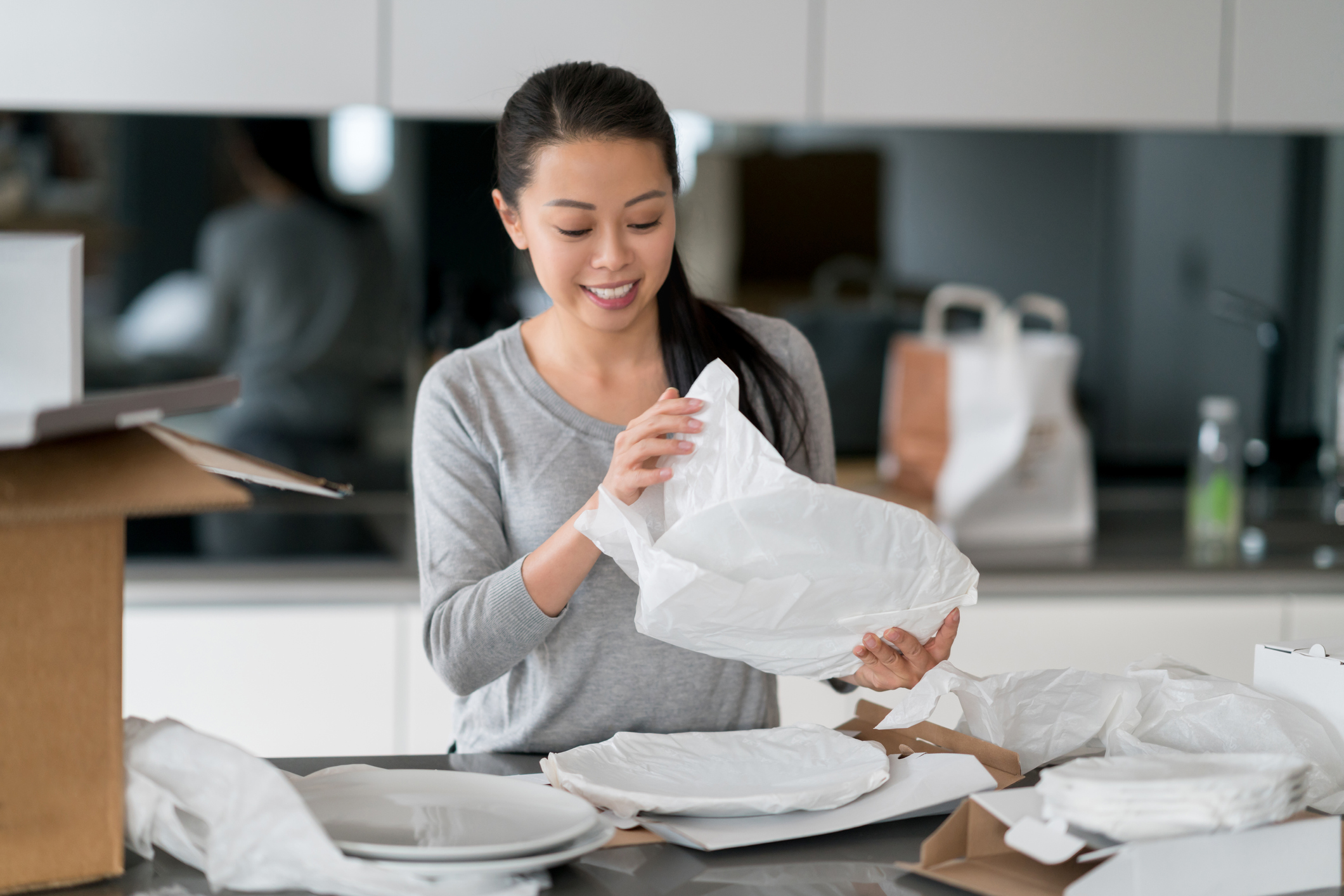Fine china is usually much more sentimental than everyday dishware. It’s often passed down for generations or gifted on important occasions like weddings. You want to protect these valuable items.
Unfortunately, knowing how to pack china for moving or storage can be difficult without breaking a piece or two. Due to its fragile nature, protecting china during a move is a cumbersome process.
This guide will explain all the necessary steps to keep your dishes safe in a moving box. If there is one thing to remember, too much packing material is better than not enough. Don’t take shortcuts that could ultimately result in shattered dishes.
1. Gather Supplies and Prep a Work Area
A little prep work goes a long way in streamlining the packing process. If you have a lot of fragile china to wrap, enlist the help of friends and family and consider an assembly line. One person can wrap, one can construct and prep moving boxes, and one can place the china inside the box.
First, clean off a work surface for the packing process. If you have enough room, designate a small section for each type of china you’ll be packing. This extra work area is helpful if you have more than one person packing dishes. One can be working on bowls while the other works on plates.
Here are some packing supplies to have on hand:
- Moving boxes
- Packing paper or tissue
- Bubble wrap
- Packing tape
- Optional: Dish packs
Is it okay to pack china in newspaper?
It is not recommended to wrap china in newspaper. Any dishes, whether china or not, shouldn’t be wrapped in newspaper as the ink could bleed on the items. The ink could then stain the china and render it ruined. When packing china, it’s best to use packing paper.
2. Cut Pieces of Packing Paper to Size
Cut several sheets of packing paper and stack them by size. You’ll need different sizes for each type of dish you’ll be packing. Each sheet should be just large enough to cover all sides of the china. By cutting these sheets in advance, you’ll save paper and be able to work more efficiently when packing each dish.
If your china is exceptionally fragile, old, or expensive, substitute packing paper for bubble wrap. You will want to tape the bubble wrap down as you would with packing paper to prevent the wrapping from coming undone.
What are the best china packing materials?
When wrapping china, you want to use packing or tissue paper, securing it as needed with scotch tape. Use bubble wrap or packing peanuts to fill empty space in the box as you pack to keep the china from moving around.
Related Article: The Ultimate Moving Checklist + Free Moving Printables Kit

3. Wrap Plates in Packing Paper One at a Time
For fine china, place a plate face down on the packing paper sheet. Fold each corner inwards and bunch the paper together at the center of the plate to create a seal. Use a small piece of scotch tape or packing tape to secure the paper in place.
Wrap each piece of china individually to prevent scuffs and breakage. Avoid stacking plates and wrapping them together like you would when packing more durable dishes.
4. Use a Rolling Technique to Wrap Drinkware
To pack crystal vases, cups, and stemware, lay down a piece of packing paper in your work area. Next, place one cup at a corner of the sheet and roll the china down the length of the paper. Take the excess paper on top and stuff it into the opening of the glass. Twist the excess paper and gently wrap the twisted end around the base.
5. Add Extra Packing Paper Inside Bowls and Cups
Pack bowls and teacups by placing the china in the center of the packing paper. Take each corner and fold it into the center of the bowl or cup. Take an extra sheet of paper and crumple that into a ball. Place the ball in the opening of the dish so that there is a thick layer of padding.
6. Line the Bottom of a Moving Box with Packing Material
Line the bottom of the box with a layer of bubble wrap, densely packed paper, or peanuts. You want at least two inches of padding on all sides of the moving box, especially on the bottom.
Select a moving box for each type of china. Depending on the size of your service, you’ll want one box for cups, one or two boxes for plates, and so on. The smaller the box and the more packing material you use, the safer your china will be in transit.
What are the best fine china packing boxes?
Cardboard is the best fine china packing box to use. Search for either large or small cardboard boxes that are sturdy. Double-walled dish boxes can also serve well for fine china packing. Secure the boxes with clear packaging tape, ensuring you secure the ends with two to three layers.
Related Article: How to Pack Moving Boxes Efficiently
7. Carefully Pack Each Moving Box
There are special moving boxes known as dish packs with individual dishware sections. If you opt to use these, ensure you fill in all extra space around each dish with packing material so the dishes cannot move at all. If you are using a regular moving box, pick a small or medium–sized box where you can fit 6-12 pieces in snuggly.
Avoid overpacking large moving boxes with fine china. This is a recipe for disaster, as heavy boxes are more likely to be dropped. You risk losing most of your collection if the box is mismanaged.
As you pack, keep similar items together in the same box. Not only does this help keep your boxes organized, but it’s easier to securely fit the same type of items into a box.
Tips on packing china and crystal:
- Plates. Place one plate right-side-up in the box and put a thin piece of bubble wrap on top. Continue stacking the plates this way until you’ve reached ¾ of the way up the box. Stuff the sides of the box tightly with packing material and do the same on the top.
- Bowls. Stack bowls vertically inside a moving box, leaving a few inches on the outer edges of the box for packing material. If you have room to add another layer, make sure to put an inch of bubble wrap in between.
- Drinkware. Place glassware on its side inside a moving box, keeping a little bit of space in between each glass that you can stuff with packing material.

8. Seal the Moving Box and Label it Carefully
Before you close and seal the moving box, ensure at least two to three inches of packing material is on the top and sides of the box. Densely pack the material in so there is absolutely no movement inside the box. Avoid pushing too much when packing, as you could risk breaking the china if too much force is used. Next, seal the box with packing tape and create a label.
Labeling moving boxes is an essential part of the moving process. Take your time to write down the exact contents inside the box, such as the type of china and roughly how many pieces. This inventory is helpful in the event of damage and when unpacking your china. Also, make sure that you mark which side is up and write ‘fragile’ in large letters on each side of the box.
Related Article: Best Packing and Moving Tips: How to Make Relocating Less Stressful
9. Stack the Heaviest Boxes on the Bottom
When you stack your boxes to get ready for a move, don’t stack them too high. One or two boxes high is plenty. Keep the heavier boxes on the bottom and stack the lighter ones on top so the cardboard doesn’t become compromised.
With these tips on how to pack china for moving or storage, you can reduce your moving stress and save some time and energy. Your delicate items will be well-preserved and ready to enjoy in your new home or pulled from storage for your next fancy dinner.
This post originally appeared on the Life Storage Blog on 2/5/19 and was revised on 6/5/23 to provide new information.







